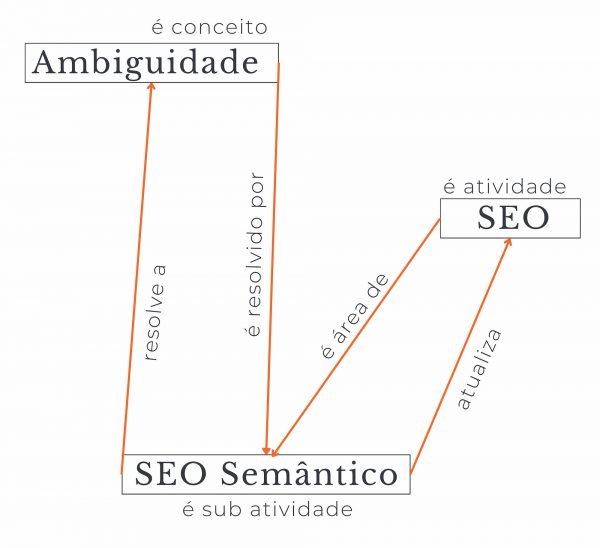The importance of disambiguation in semantic SEO.
Semantic SEO differs from older optimization because it is heavily based on the meaning of what is said in the content. Therefore, eliminating the double meaning of a phrase (called disambiguation) is one of the first steps that need to be taken semantic optimization project .
In linguistics , disambiguation is the process of clarifying the meaning of something that has multiple possible interpretations, eliminating ambiguity. It is the act of making clear the meaning of a word, phrase, or concept that can be understood in more than one way.
Therefore, in the Semantic Workflow that I created, right after finding the knowledge in which your project is embedded, we begin to build a taxonomy , because it helps us define, without ambiguity, the concepts and terms that will be used. Therefore, the action or process that eliminates the ambiguity of a linguistic structure, helping us to make its real meanings explicit, is one of the fundamental elements of Semantic SEO.
Ambiguity and Semantic SEO
What is the relationship between SEO and ambiguity?
To be direct, the connection lies in the retrieval of information .
SEO works by constantly and methodically improving the content we put on the internet. By content, I mean the collection of posts, pages , tools, platforms, and more. Everything your organization puts on the internet, to me, is content. And our job as SEO professionals is to help retrieve the information contained in that content.
Ambiguity is a major obstacle to information retrieval.
Marcelo Schiessl and Marisa Brascher in Ontology: Ambiguity and Precision
The use of taxonomies and ontologies are the greatest contributions that Information Science has made to the organization and retrieval of information, as described by Schiessl and Brascher:
Information Science seeks to organize collections aiming for a balance between user and information, and to this end, it uses philosophical and computational approaches.
It is in this balance between what users need and where the information they need is located that these seemingly distinct areas connect: SEO and Information Science, especially if we consider the Semantic Web as a field of activity for professionals involved in both areas.
Taxonomies in general, and ontologies in particular, allow us to automate the qualification of content indexing maps " that are created between entities and their relationships. For example:
If I'm writing content about Ambiguity and Semantic SEO, I can create relationships between these three entities structured data connected to the HTML
- Ambiguity
- SEO
- Semantic SEO
Described more or less like this:

The relationship I create between the three entities can be described in this simple representation in several ways, depending on the knowledge domain my site is in, the content structure I've chosen to use, the taxonomy I've customized for the project, and many other criteria.
But something that doesn't change is the fact that the connections between them carry meaning; they are semantic. And semantic applications, which use, for example, natural language processing and other artificial intelligence techniques, can transform this structure into a knowledge graph .
How do I use knowledge graphs
Artificial intelligence, taxonomies and internal links
In this post you are reading now, there is a small excerpt from a knowledge graph I created. I use WordLift to connect the taxonomy I customized for my website with the entities I described in the form of a controlled vocabulary , generating a network of links enriched with structured data, through Artificial Intelligence, connected to databases such as DBpedia .
This allowed me to create an Knowledge Graph , specializing in Semantic SEO and its relationship with Library and Information Science, the new focus of my work and, consequently, this blog.
How do semantic SEO and taxonomies help with disambiguation in your projects?
We can divide the objectives of generating certainty about the subjects you address in your content into two categories:
User search intent and improved search .
Semantic Workflow methodology helps you move more confidently throughout the entire process.
User intent
For each search performed by each user at a given time, we can categorize them by types, which we currently call intents.
There are four search intents a user may have:
- Informational : the visitor wants to find an answer to a specific question.
- Navigational : the visitor wants to find a specific page or website.
- Commercial : the visitor wants to investigate brands or services.
- Transactional : the visitor wants to complete an action (conversion).
This is a way for us to logically organize what we understand as the information search moment, where all previous interactions are part of a set of decision-making processes, impacting the moment when a person needs to do something and goes to a search engine or website to perform a search.
Whether searching on Google or going directly to your website's internal search engine, this person has a more or less defined objective, which guides how they search and what they understand as useful information. It is at this point that the prior organization of information by the team involved in the projects (whether building the platforms or creating the content) has a direct impact on delivering this information, relevant to each user's intention.
Using taxonomies at the beginning of your project helps you focus on what's important for your company to say about the knowledge domain it's connected to. Furthermore, it helps you stay on topic with what your visitors (and potential customers) are looking for, definitively matching information with intent.
Search results
Search engines like Bing and Google have created their own ontologies, their own knowledge graphs, and they use them to solve the same problem that I am addressing in this post: ambiguity.
When you perform a search on either platform, you trigger algorithms that navigate these semantic networks—composed of trillions of concepts, entities, and their relationships—in microseconds, seeking to provide the best answer to your query.
The level of certainty regarding the best information to answer your question may vary: algorithms like MUM have been providing increasingly better and more complete results. But one thing is certain: for search engines to continue evolving, the answers need to be increasingly accurate.





Post comment